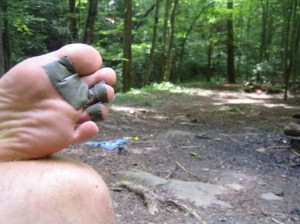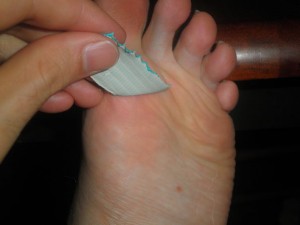Blisters and Duct Tape
I know there are websites out there with a million uses for duct tape; but let me share one of my primary uses for that amazing product. To be honest I love the stuff, but I’ve always thought duct tape wallets, hats, boats, and whatever else people make with the stuff is mildly worthless and a waste of money. But I do always keep a small amount in my bug-out-bag for a specific purpose. If you are worried about space get something small like a popsicle stick and re-roll the duct tape around it into a more consolidated form.
There are some references for mole skin here but the stuff is thick and has never worked as well for me as simple duct tape.
So I’m currently engaged in some training in the Midwest and I’ve been putting a lot of miles down on my feet. As to be expected I ended up with a massive deep blister on the ball of might foot which was hurting pretty bad. So what did I do? The only logical thing; pop it and put duct tape over it.
For those of you used to mole skin this might sound odd; but for those in the military who have done long ruck marches this is the only way to travel. I know some hikers and long distance runners that tape up the entire soles of their feet before embarking on a long trek or run, and they all swear by the stuff.
Me personally, I find that the civilian silver stuff works the best; and within a day of walking around on this stuff I couldn’t even feel the beast that had left me hobbling for an entire day.
Blisters a caused by friction. Your skin is not slippery and applying mole skin, or duct tape over a hot spot will add a buffer layer between your skin and inner shoe. Many military types also wear the more slippery dress socks overtop of their standard military issue socks for long ruck marches. These buffers rub against the shoe as it attempts to slide against the skin of your foot. Some great pointers from outdoors.stackexchange.com:
- Use enough tape/mole-skin to cover an area larger than the hot-spot. If the hotspot is on the edge of your heel go ahead and wrap the tape up and around the side/bottom so it doesn’t shift/move. (Duct tape, being cheaper than mole-skin is better for large area applications.)
- Cut mole-skin in a circle (or at the very least, round the corners) to prevent the corners from catching on socks, shoes, etc and peeling off. (With duct-tape, I usually just snip the corners off, since it tends to stick better.)
- Use tincture of benzoin (a sticky substance) to help the moleskin adhere better to your foot.
- If you just have a hot-spot, I find duct-tape works better since it is thinner, and provides a near-frictionless surface.
- If you already have a blister, mole-skin / mole-foam (thicker) is better especially if you cut a hole in the center and stick a dough-nut of mole-skin around the blister. The added thickness helps keep your shoe from rubbing the blister in the middle
- Moleskin, being thicker, can take up space in tight-fitting shoes, and shift the fit-problem / wear elsewhere.
- Some areas (between toes) it might be better to wrap the rubbing toe than the rubbed toe (personal preference).
- Using too SMALL of a piece of tape/other will result in it shifting, falling off, balling up, etc. In that case, just try to re-apply a larger piece.
According to Lifehacker.com duct tape should not be applied directly to a blaster resulting in a open would, while this is important with open flesh covering a large area, I’ve personally never had problems with small blisters; and as stated above, I do the first thing doctors say not to do, I rip the dead skin off.
From Lifehacker: “Are blisters ruining your day? Do band-aids keep sweating off? No moleskin on-hand? Try duct tape! It cushions the blister and won’t come off. Many walkers and runners swear by it.
Apply the duct tape when you first feel burning and, hopefully, before a full blister develops. Lay it as smoothly as possible, avoiding wrinkles.
Blisters already exist? Shield them from the duct tape glue. Cut out a circle of paper or gauze, attach it to the center of the duct tape and cover the wound with the non-sticky part.”
From Ben Crowell on outdoors.stackexchage.com :” A common way to use duct tape is to wrap it around a toe that’s developing a blister. This technique works better with duct tape than with moleskin. All of this works best as a prophylactic. Apply the tape as soon as you start to feel a problem starting.”
As a side note should you pop your blisters? I always do but that doesn’t mean it’s the correct answer. This is what webmd.com has to say: Most blisters caused by friction or minor burns do not require a doctor’s care. New skin will form underneath the affected area and the fluid is simply absorbed. Do not puncture a blister unless it is large, painful, or likely to be further irritated. The fluid-filled blister keeps the underlying skin clean, which prevents infection and promotes healing.
But if you need to pop a blister:
- Use a sterilized needle or razor blade (to sterilize it, put the point or edge in a flame until it is red hot, or rinse it in alcohol).
- Wash your hands and the area thoroughly, then make a small hole and gently squeeze out the clear fluid.
- If the fluid is white or yellow, the blister may be infected and needs medical attention.
- Do not remove the skin over a broken blister. The new skin underneath needs this protective cover.
- Apply an antibiotic ointment or cream.
- Look for signs of infection to develop, including pus drainage, red or warm skin surrounding the blister, or red streaks leading away from the blister.




Leave a Reply